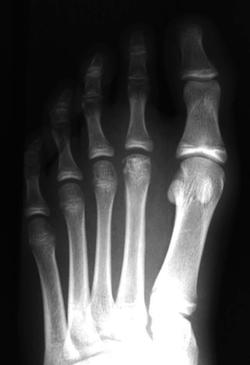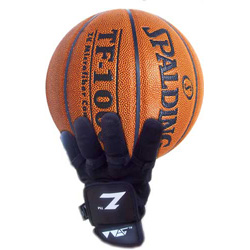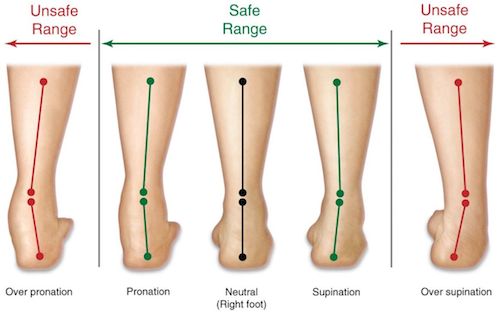
26 Bones!
Ever wonder why so many people have knee and hip pain when the foot is obviously more fragile? Shoes can protect your feet, but they often cause more problems up the chain.
Your feet form an intricate foundation for a complicated system – there’s a lot that can go wrong.
The soles of your feet have hundreds of nerve endings and joint motion receptors that send constant feedback to your brain about the environment and body position.
Ignoring your feet sets you up for pain and fatigue throughout your body, and an increased likelihood of injury when you push your limits.
Sounds bad, right? So let’s get this sorted out, and make sure you’re armed with the info necessary for maintaining healthy feet.
The Science of Barefoot Standing
Each of your feet has 26 bones, 3 different arches, and a variety of specialized muscles to control your ankle, foot, and toe movements.
Research shows that during barefoot standing, 60% of weight is supported by the heels, 28% by the forefoot, and 8% by the mid-foot. For you visual learners, that looks like this:
All that complicated circuitry we discussed above works together to keep you standing upright (for you physicists, your body is an unstable inverted pendulum). Fortunately, you don’t need a fancy degree to understand why barefoot is better. Let’s look at a simple metaphor to clear it up.
How Your Feet and Brain are Like Cruise Control in a Car
If you set your car’s cruise control to 70 mph, your car stays at roughly 70 mph. We’ve all done it, but it’s actually a cool technology. Once you set your desired speed, your car constantly checks its actual speed against your desired speed. If the current speed is too high, it slows you down; too low, it speeds you up. This is a “control loop” that takes inputs of desired speed and current speed, and performs outputs of throttle position motor movements.
Your feet and brain together also form a control loop. Your brain has a “desired balance” input, and can tell (from sensors throughout your body) what your “current balance” actually is. Your brain constantly compares your desired and current balance states, and enacts changes through your motors (muscles) to achieve/maintain the desired balance condition. Very complicated stuff that occurs multiple times per second.
How Shoes Disturb Your Brain’s Balance Control
Shoes hurt this system because they limit the motion the joints in your feet experience, atrophy your muscles, and reduce the quality of the sensory input information that your feet return to your brain.
Feet confined by shoes are bound to virtually the same surface all day long. Your foot is always in contact with the same contoured surface of the shoe. This flattens the signal your brain receives about the current state of your foot activity.
Putting shoes on your feet obscures your brain’s ability to determine how well you’re balancing, and whether its commanded changes in muscle activity are achieving the desired goal. This will cause your muscles to over- or under-react when an adjustment to your balance is needed, and it actually causes your brain to work harder.
If you’re wearing shoes right now, try to balance on one foot with your eyes closed. Quick – what was the phone number of your first best friend? Now say it backwards. Now try again barefoot.
When you wear shoes, your brain has to solve some complicated motion equations on the fly, because the sensors in your feet aren’t reporting back effectively. Imagine if you wore thick leather gloves your whole life. Could you even hope to shoot a basketball accurately?
What This Actually Means for Your Health and Happiness

Walking with shoes is like playing basketball with gloves.
With the control loop disrupted, your brain is bound to take shortcuts and send the wrong signals to your muscles. This increases the chances of unnatural tissue loading. Problems like locking your knees, standing asymmetrically, or putting too much weight on your heels.
It also blunts what should be important overuse signals. Sure, you might be able to run further in a pair of cushy athletic shoes. But is running unnaturally far really a good idea?
When you’re wearing shoes, your brain will likely keep at least one muscle group activated too long – throwing off the symmetry between opposing muscle groups.
That means increased likelihood of sprains, strains, and tears. And don’t even get us started on the damage done to our elderly population. More bare footing about could have prevented a lot of broken hips.
As touched on earlier, beyond the physical effects, disrupting one of your brain’s many control loops may have mental effects as well. In small experiments we’ve run in our office, standers performed as much as 10-15% better on cognitive tests when barefoot than when wearing hard-soled shoes. And as we’ve covered before, increasing mental performance just 10% can have huge positive effects.
Restore Healthy Brain-Foot Connection by Standing Barefoot
Just take off your shoes! Your feet will be able to touch and feel the surface of the floor, the carpet, and your anti-fatigue mat. Movements such as toe curling, arch flexing, and foot pivoting will start happening naturally and spontaneously when your feet are freed from their evil shoe prisons. And we know how important to your health a little extra movement is.
If you work in an uptight office – grab a pair of office-appropriate slip-ons (or for ladies here). You’ll be able to pop your shoes on at a moment’s notice to avoid any embarrassment. This will allow you to easily slip off your shoes at your desk, and slip them back on anytime you leave your workstation.
Take it easy and plan a gradual transition if this is new for you. Remember what we said about muscle atrophy. Pay attention to the posture of your feet and use your quads and rear end to keep your feet from overpronating until you can restore the natural musculature and instincts of your feet. The Achilles tendon on the back of your heel should be vertical when you stand. No slouching!

Keep your achilles tendon vertical!
[image credit]
The post How Shoes Hurt You & Why Standing Barefoot is Healthier appeared first on Quitting Sitting.






















